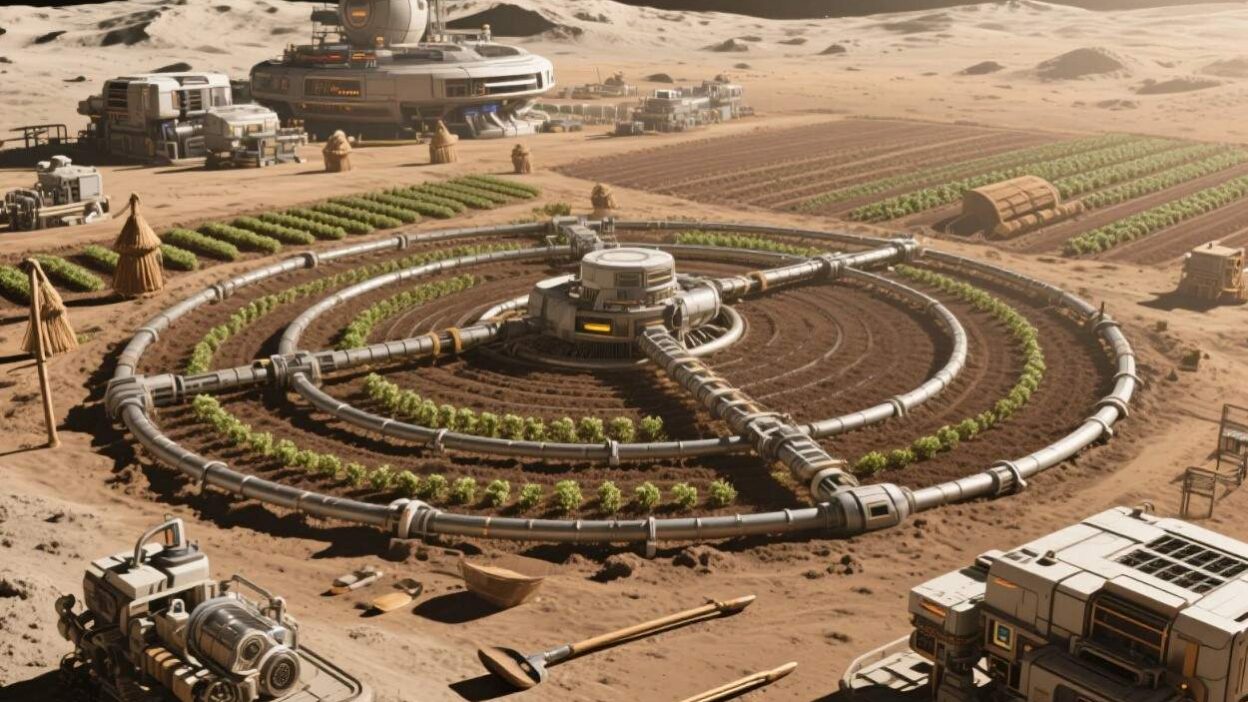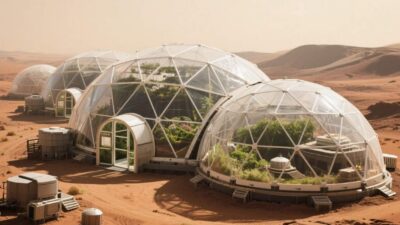The Imperative of Lunar Agriculture for Lunar Colonies
Humanity’s ambition to establish permanent lunar colonies—envisioned by NASA’s Artemis program, China’s lunar base plans, and private space ventures—hinges on one critical challenge: sustaining life. While initial missions will rely on supplies from Earth, long-term colonization demands self-sufficiency. Lunar agriculture—growing food, raising livestock, and producing resources in the Moon’s harsh environment—emerges as a cornerstone of this vision. By harnessing local resources and innovative technologies, lunar agriculture will transform the Moon from a temporary outpost into a thriving, self-sustaining ecosystem. This report explores the challenges, technologies, and opportunities driving lunar agriculture, and its role in securing humanity’s future beyond Earth.
The Lunar Environment: A Hostile but Resource-Rich Frontier
The Moon’s extreme conditions pose unique challenges for agriculture:
- Temperature Extremes: Surface temperatures range from -180°C (-292°F) in shadowed craters to 120°C (248°F) in sunlight, requiring controlled environments for plant growth.
- Radiation Exposure: The Moon lacks a global magnetic field, exposing surfaces to harmful solar and cosmic radiation (up to 300 mSv/year, 30x Earth’s background).
- Thin Atmosphere: A near-vacuum (10⁻¹⁰ bar) means no natural protection from radiation or micrometeoroids, and no oxygen for aerobic life.
- Water Scarcity: Liquid water is absent, though ~600 million tons of ice exist in permanently shadowed polar craters (detected by NASA’s LCROSS mission).
- Regolith Limitations: Lunar soil (regolith) is nutrient-poor, abrasive, and lacks organic matter, making it unsuitable for traditional farming.
Despite these hurdles, the Moon offers unique advantages: abundant sunlight (14 Earth days of daylight), low gravity (1/6 Earth’s), and access to rare elements (e.g., helium-3 for fusion energy). Lunar agriculture leverages these to build a closed-loop, sustainable system.
Current Innovations: Pioneering Lunar Agriculture
Researchers and space agencies are testing technologies to adapt Earth’s agricultural practices to the Moon. Key advancements include:
1. Soil Substitutes and Regolith Engineering
Lunar regolith is being processed to create fertile “lunar soil” by mixing it with organic matter (e.g., compost, algae biomass) and nutrients (nitrogen, phosphorus). For example:
- NASA’s Regolith Additive Manufacturing (RAM) project uses 3D printing to bind regolith with polymers, creating durable, nutrient-rich substrates for plant growth.
- The China Lunar Exploration Program (CLEP) has successfully grown Arabidopsis thaliana (a model plant) in simulated lunar regolith mixed with organic fertilizers, demonstrating proof-of-concept.
2. Controlled Environment Agriculture (CEA)
Closed-loop systems mimic Earth’s biosphere, regulating temperature, humidity, light, and CO₂:
- Hydroponics/Aeroponics: Water-based or mist-based systems reduce water use by 90% compared to soil farming. NASA’s Advanced Plant Habitat (APH) on the ISS uses LED lighting and hydroponics to grow crops like radishes and peppers.
- Bioreactors: Microbial communities break down organic waste (e.g., astronaut feces, plant residues) into fertilizer, closing the nutrient loop. The Ecosphere project (ESA) uses algae to recycle CO₂ into oxygen and biomass.
3. Radiation and Temperature Mitigation
- Shielding: Underground habitats or regolith-covered greenhouses (using 3D-printed regolith bricks) block radiation and stabilize temperatures.
- Genetic Engineering: Crops are being modified to tolerate radiation (e.g., Arabidopsis with enhanced DNA repair genes) and low gravity (e.g., tomato plants with stronger root systems).
4. Water Harvesting and Recycling
Lunar ice extraction technologies, such as NASA’s Volatiles Investigating Polar Exploration Rover (VIPER), aim to mine water from polar craters. Once extracted, water is recycled in closed systems, with only minimal losses (e.g., via plant transpiration or human consumption).
Benefits of Lunar Agriculture for Sustainable Colonies
Lunar agriculture is not just about food—it’s a linchpin of self-sufficiency:
- Food Security: Locally grown crops (e.g., potatoes, wheat, leafy greens) reduce reliance on Earth shipments, which are costly ($10,000/lb for cargo to the Moon) and logistically risky.
- Resource Efficiency: Closed-loop systems recycle water, nutrients, and organic waste, minimizing imports. For example, a 100-person colony could recycle 90% of its water and 80% of its organic waste using lunar agriculture.
- Economic Viability: Surplus crops (e.g., oxygen-producing algae, medicinal plants) could be exported to Earth or used in lunar industries (e.g., biofuels, bioplastics), generating revenue.
- Scientific Innovation: Lunar agriculture drives advancements in biotechnology (e.g., radiation-resistant crops), materials science (e.g., regolith-based building materials), and closed-loop life support.
Challenges and Barriers to Scaling
Despite progress, lunar agriculture faces significant hurdles:
1. Technical Limitations
- Energy Requirements: Maintaining controlled environments (lighting, heating, CO₂ generation) demands substantial energy. Solar power is intermittent (14-day night), requiring backup from nuclear reactors (e.g., NASA’s Kilopower project).
- Equipment Durability: Lunar regolith is abrasive, and radiation degrades electronics. Developing radiation-hardened, low-maintenance tools is critical.
2. Biological Risks
- Contamination: Earth microbes (forward contamination) could disrupt lunar ecosystems, while lunar microbes (if any) might threaten human health (backward contamination). Stringent sterilization protocols and biosecurity measures are needed.
- Crop Viability: Most Earth crops require specific conditions (e.g., soil pH, microbial symbionts) absent on the Moon. Long-term studies are needed to identify “space-adapted” species.
3. Logistical and Financial Barriers
- Infrastructure Costs: Building lunar habitats, greenhouses, and water extraction systems requires massive upfront investment. Public-private partnerships (e.g., NASA’s CLD Program) and international collaboration are essential to share costs.
- Regulatory Gaps: No global framework exists for lunar resource use or agricultural regulation, risking conflicts over water, land, or intellectual property.
The Future: Scaling Lunar Agriculture for Permanent Colonies
The path to sustainable lunar colonies hinges on:
- Technology Integration: Developing modular, scalable systems (e.g., 3D-printed greenhouses, automated harvesting robots) that adapt to lunar conditions.
- International Collaboration: Projects like NASA’s Artemis Accords and ESA’s Lunar Village initiative foster shared research, reducing duplication and accelerating progress.
- Ethical and Legal Frameworks: Establishing guidelines for resource use, biosecurity, and equitable access to lunar agriculture benefits (e.g., ensuring developing nations participate in research).
- Long-Term Testing: Conducting multi-year experiments (e.g., NASA’s Lunar Surface Science Station) to validate crop yields, system reliability, and human health outcomes.
Cultivating a New Era of Lunar Life
Lunar agriculture is more than a technical challenge—it is a vision of humanity’s resilience and ingenuity. By transforming the Moon’s harsh environment into a thriving agricultural hub, we lay the groundwork for permanent lunar colonies that are self-sufficient, sustainable, and connected to Earth. As we plant the first seeds on the Moon, we are not just growing food—we are cultivating the future of human exploration.
The Moon’s soil, once barren, will soon bear the fruits of innovation, proving that even in the most hostile environments, life finds a way to thrive.



